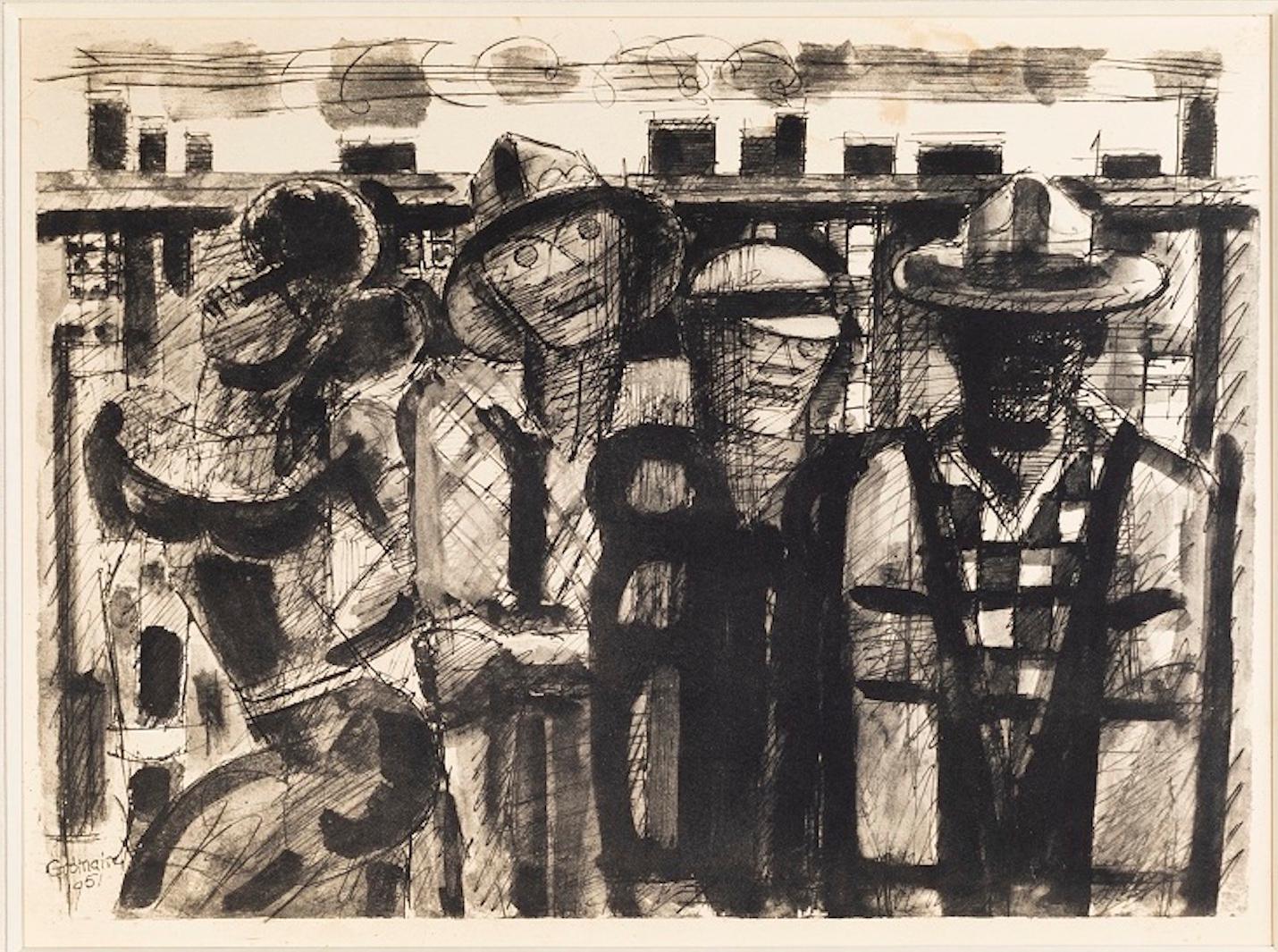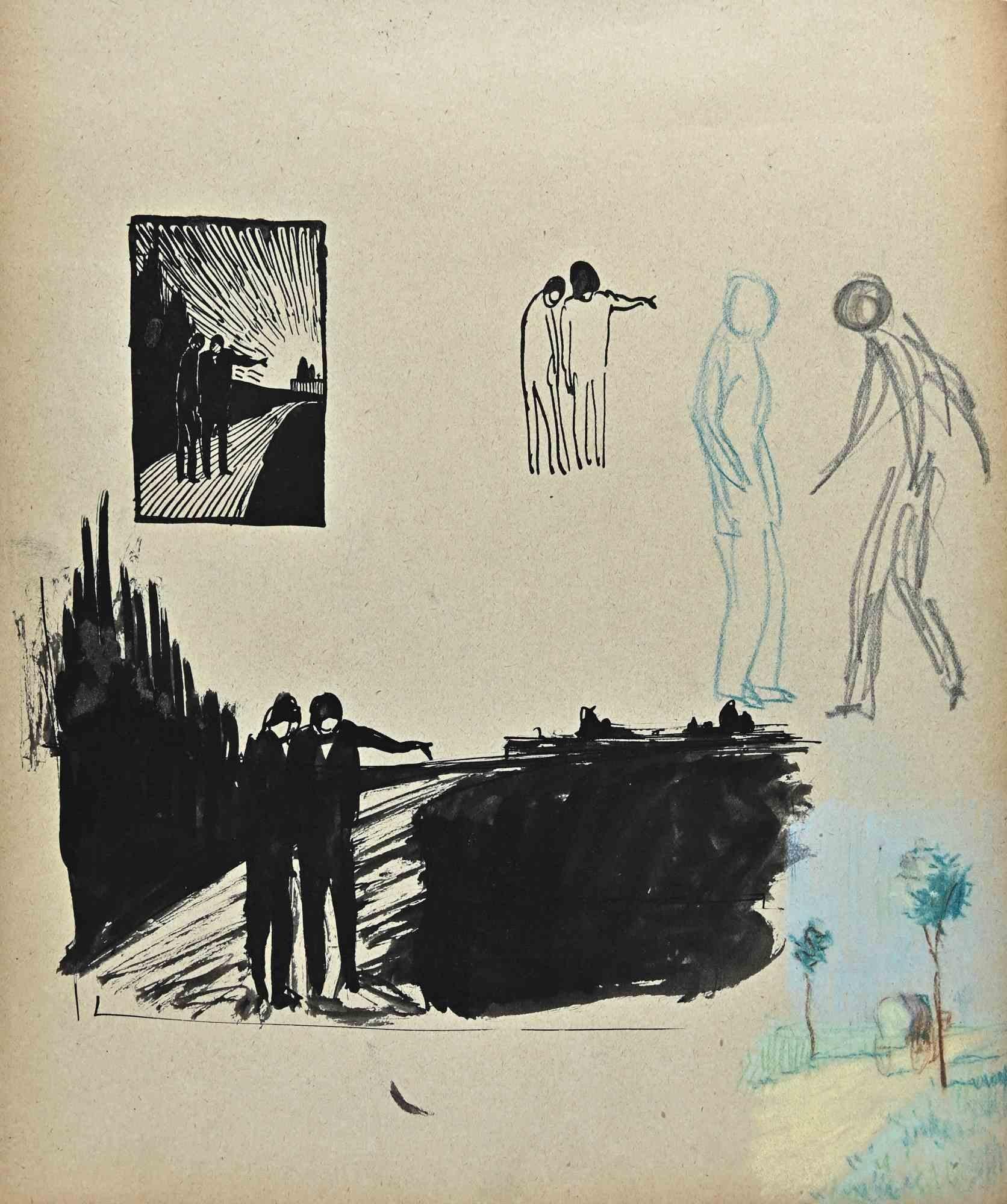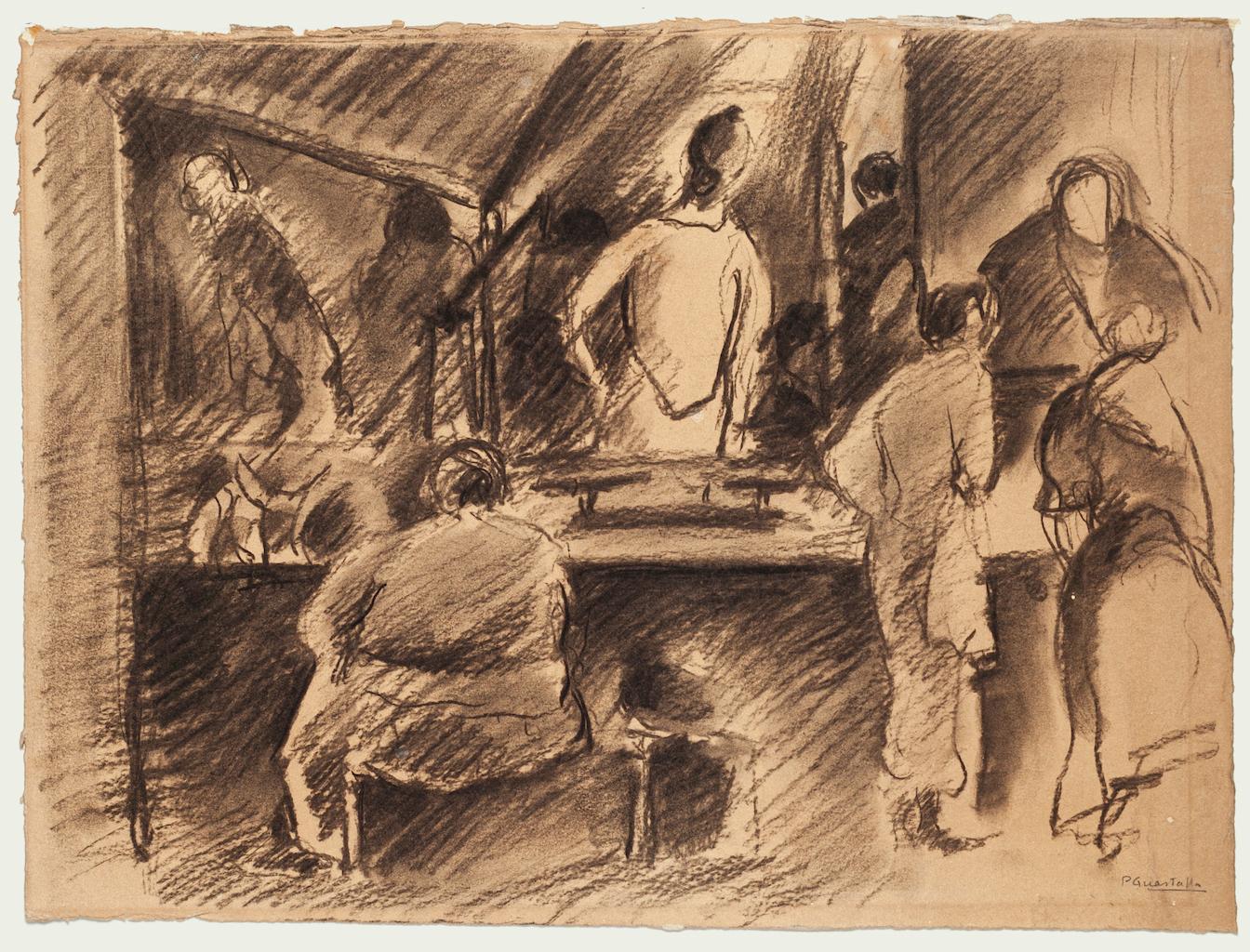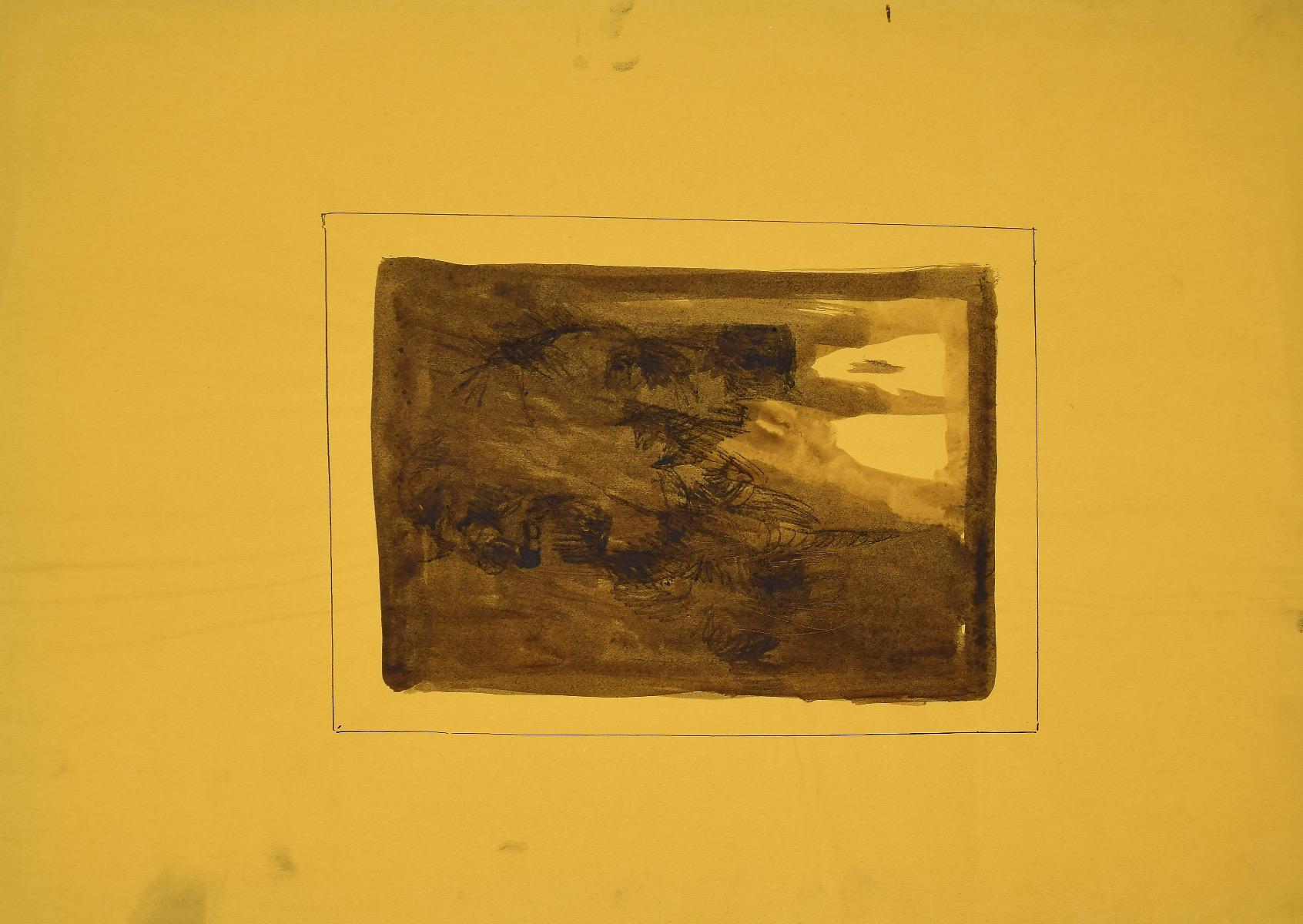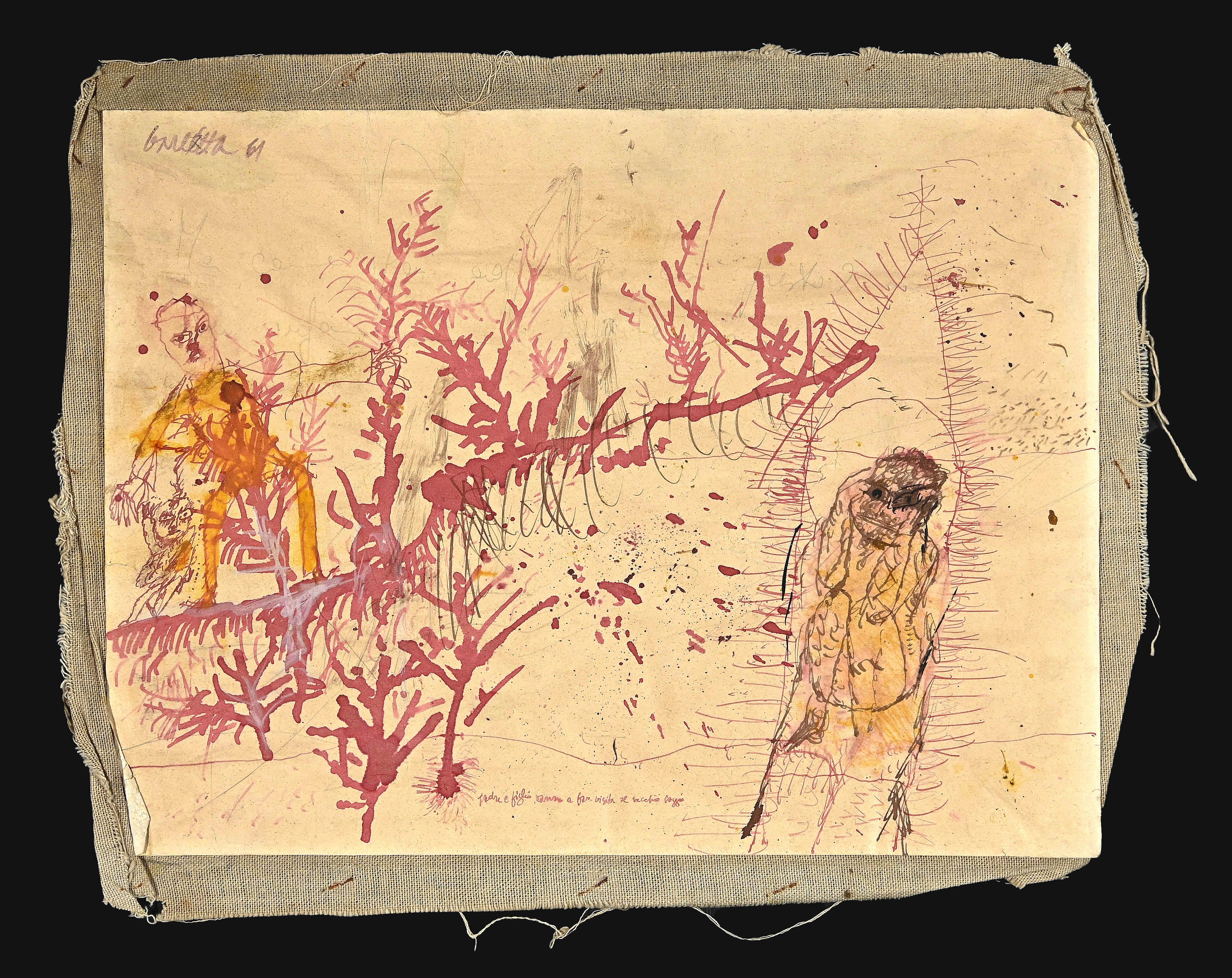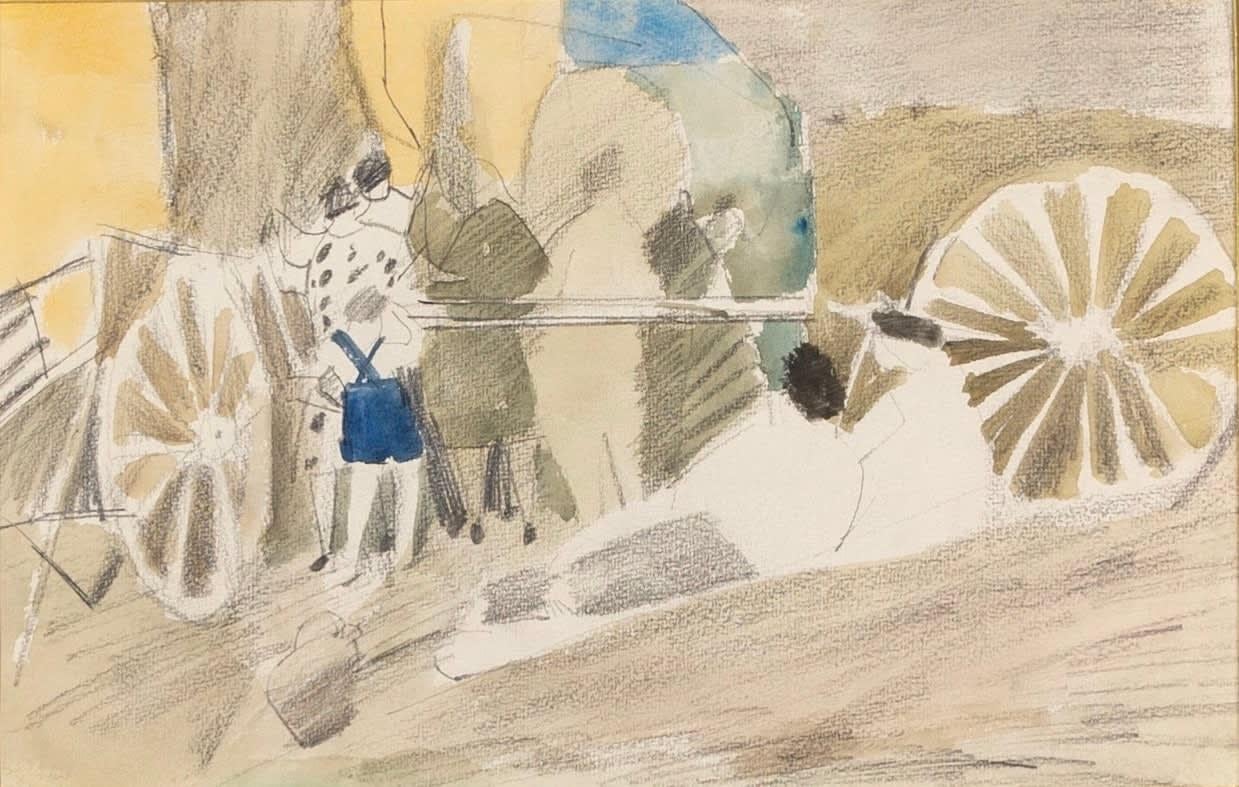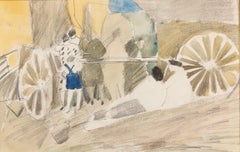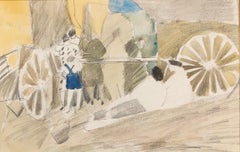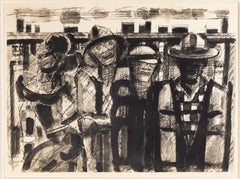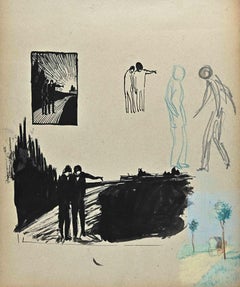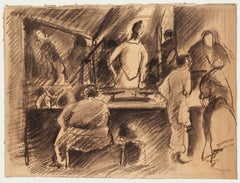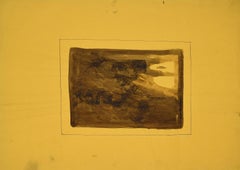Items Similar to Study for Men in the Trench, Pen, Ink & Watercolour on Paper Painting 1950 circa
Want more images or videos?
Request additional images or videos from the seller
1 of 6
Reginald BrillStudy for Men in the Trench, Pen, Ink & Watercolour on Paper Painting 1950 circa1950 circa
1950 circa
Price Upon Request
Price Upon Request
Price Upon Request
Price Upon Request
Price Upon Request
Price Upon Request
Price Upon Request
Price Upon Request
Price Upon Request
Price Upon Request
Shipping
Retrieving quote...The 1stDibs Promise:
Authenticity Guarantee,
Money-Back Guarantee,
24-Hour Cancellation
About the Item
Study for Men in the Trench, Pen, Ink & Watercolour on Paper Painting 1950 circa
Additional information:
Medium: Pen, ink and watercolour on paper
11 3/4 x 26 in
29.8 x 68.5 cm
Reginald " Reggie" Brill was a versastile 20th century artist and teacher.
Brill was born in London in 1902 and spent his early childhood there and in Yorkshire. By the time of the First World War, at the age of 13, he was living in lodgings in London, working in a City office and attending St Martins School of Art in the evenings. Considering his lack of education, winning a scholarship to The Slade (now part of University College London) in 1921 where he studied under Henry Tonks for three years, was a huge achievement.
On leaving The Slade he found patronage in Lincolnshire, but by the time of the General Strike (1926) he had returned to London and was working on Lansbury's Labour Weekly. He married Rosalie, also an artist, and in 1927 won the Prix de Rome in Decorative Painting. Following two years at The British School in Rome, Brill went to teach at Blackheath School of Art. During 1930 he spent three months painting in Egypt and it was there that he met Col. T G Gayer-Anderson, one of the twin brothers who were to bequeath The Little Hall in Lavenham as a hostel for art students. It was there that Brill retired to act as warden, thus continuing his nurturing of art students until his death in 1972.
Brill took up his appointment at The School of Art, Kingston upon Thames in January 1934. It was situated in the Technical Institute (Kingston Hall Road) and Brill found it bohemian and disorganised. He proceeded to inject enthusiasm, order and discipline. Within 5 years of his appointment a purpose-built School of Art was opened in Knights Park. It remained open throughout the war and by 1945 there was a waiting list for places. Under the skilled and totally dedicated direction of Brill, Kingston School of Art became established with national reputation for excellence. In 1961 Sir Charles Wheeler opened the new building at Knights Park. Costing £100,000, this more than doubled the size of the Art School.
Brill, was a well-known figure in Kingston. His eloquence made him popular as a guest speaker and his promotion of Art and Design stretched well beyond the doors of Knights Park. Apart from establishing two of the main buildings which makeup what is now known as the Faculty of Design, one of the most visible local contributions he made was the setting up of a topographical collection of paintings depicting Kingston, which has since become known as The Brill Collection at Kingston Museum. Brill gained huge respect and admiration from the hundreds of pupils who studied at Kingston during his 30-year leadership.
He published two books, Modern Painting 1946 and Art as a Career 1962, both bearing a strong educational angle. He regularly exhibited along with leading artists of his era at The Royal Academy, both his paintings and his acutely observed drawings. All the while he was a prolific artist, although reading his diaries, intensely self-critical. His perfectionism, acute powers of observation and relentless research can be seen in his drawings, which via the media and methods he explored throughout his life reflect mid 20th century British Art at its most typical. His major series of work, known as 'The Martyrdom of Man', was carried on in parallel to his career as a teacher. These paintings reflect his care for fellow man and depict people at work, e.g., The Operation, The Jury, Linemen, Waiting Room and Rest, which recently sold at Sotheby’s and was specially restored for The Brill Retrospective. His smaller works also play with the theme of everyday events and communication amongst people, such as The Bull Ring and Market Place paintings.
Brill's name is associated particularly with human figure compositions, but he also worked on landscapes, portraits and details of plants, animals, interiors etc. As one would expect he moved from one media to another, and his unusual hand painted and cut paper mosaics are beautifully designed and worked. The Englishness of his work, with its narrative theme and the emphasis on people in their environment, combined with his interest and concern in human behaviour results in a legacy of excellence as yet unexploited.
- Creator:Reginald Brill (1902 - 1974, English)
- Creation Year:1950 circa
- Dimensions:Height: 11.75 in (29.85 cm)Width: 26 in (66.04 cm)
- Medium:
- Period:
- Condition:
- Gallery Location:Kingsclere, GB
- Reference Number:1stDibs: LU2718214573232
About the Seller
No Reviews Yet
Vetted Professional Seller
Every seller passes strict standards for authenticity and reliability
Established in 2010
1stDibs seller since 2024
40 sales on 1stDibs
Typical response time: 14 hours
- ShippingRetrieving quote...Shipping from: Kingsclere, United Kingdom
- Return Policy
Authenticity Guarantee
In the unlikely event there’s an issue with an item’s authenticity, contact us within 1 year for a full refund. DetailsMoney-Back Guarantee
If your item is not as described, is damaged in transit, or does not arrive, contact us within 7 days for a full refund. Details24-Hour Cancellation
You have a 24-hour grace period in which to reconsider your purchase, with no questions asked.Vetted Professional Sellers
Our world-class sellers must adhere to strict standards for service and quality, maintaining the integrity of our listings.Price-Match Guarantee
If you find that a seller listed the same item for a lower price elsewhere, we’ll match it.Trusted Global Delivery
Our best-in-class carrier network provides specialized shipping options worldwide, including custom delivery.More From This Seller
View AllWagons in the Field, Poland, Watercolour and Charcoal Painting, 1958
Located in Kingsclere, GB
Wagons in the Field, Poland, Watercolour and Charcoal Painting, 1958
Additional information:
Medium: Watercolour and charcoal
20.6 x 32.3 cm
8 1/8 x 12 3/4 in
Tadeusz Piotr (Peter)...
Category
20th Century Abstract Paintings
Materials
Watercolor
Wagons in the Field, Poland by Peter Potworowski, Watercolour Landscape, 1958
By Peter Potworowski
Located in Kingsclere, GB
Wagons in the Field, Poland
Category
20th Century Landscape Drawings and Watercolors
Materials
Charcoal, Watercolor
Italian Scene, Pen and Ink with Wash Painting by Reginald Brill, 1950s circa
By Reginald Brill
Located in Kingsclere, GB
Italian Scene, Pen and Ink with Wash Painting by Reginald Brill, 1950s circa
Additional information:
Medium: Pen and ink with wash
33 x 48.3 cm
13 x 19 in
Reginald " Reggie" Brill was a versastile 20th century artist and teacher.
Brill was born in London in 1902 and spent his early childhood there and in Yorkshire. By the time of the First World War, at the age of 13, he was living in lodgings in London, working in a City office and attending St Martins School of Art in the evenings. Considering his lack of education, winning a scholarship to The Slade (now part of University College London) in 1921 where he studied under Henry Tonks for three years, was a huge achievement.
On leaving The Slade he found patronage in Lincolnshire, but by the time of the General Strike (1926) he had returned to London and was working on Lansbury's Labour Weekly. He married Rosalie, also an artist, and in 1927 won the Prix de Rome in Decorative Painting. Following two years at The British School in Rome, Brill went to teach at Blackheath School of Art. During 1930 he spent three months painting in Egypt and it was there that he met Col. T G Gayer-Anderson, one of the twin brothers who were to bequeath The Little Hall in Lavenham as a hostel for art students. It was there that Brill retired to act as warden, thus continuing his nurturing of art students until his death in 1972.
Brill took up his appointment at The School of Art, Kingston upon Thames in January 1934. It was situated in the Technical Institute (Kingston Hall Road) and Brill found it bohemian and disorganised. He proceeded to inject enthusiasm, order and discipline. Within 5 years of his appointment a purpose-built School of Art was opened in Knights Park. It remained open throughout the war and by 1945 there was a waiting list for places. Under the skilled and totally dedicated direction of Brill, Kingston School of Art became established with national reputation for excellence. In 1961 Sir Charles Wheeler opened the new building at Knights Park. Costing £100,000, this more than doubled the size of the Art School.
Brill, was a well-known figure in Kingston. His eloquence made him popular as a guest speaker and his promotion of Art and Design stretched well beyond the doors of Knights Park. Apart from establishing two of the main buildings which makeup what is now known as the Faculty of Design, one of the most visible local contributions he made was the setting up of a topographical collection of paintings depicting Kingston, which has since become known as The Brill Collection at Kingston Museum. Brill gained huge respect and admiration from the hundreds of pupils who studied at Kingston during his 30-year leadership.
He published two books, Modern Painting 1946 and Art as a Career 1962, both bearing a strong educational angle. He regularly exhibited along with leading artists of his era at The Royal Academy, both his paintings and his acutely observed drawings. All the while he was a prolific artist, although reading his diaries, intensely self-critical. His perfectionism, acute powers of observation and relentless research can be seen in his drawings, which via the media and methods he explored throughout his life reflect mid 20th century British Art at its most typical. His major series of work, known as 'The Martyrdom of Man', was carried on in parallel to his career as a teacher. These paintings reflect his care for fellow man and depict people at work, e.g., The Operation, The Jury, Linemen, Waiting Room and Rest, which recently sold at Sotheby’s and was specially restored for The Brill Retrospective. His smaller works also play with the theme of everyday events and communication amongst people, such as The Bull Ring and Market Place paintings.
Brill's name is associated particularly with human figure compositions, but he also worked on landscapes, portraits and details of plants, animals, interiors etc. As one would expect he moved from one media to another, and his unusual hand painted and cut paper mosaics...
Category
20th Century Landscape Paintings
Materials
Pen
Figures Talking, Oil on Paper Painting by Philip Jones, 1973
Located in Kingsclere, GB
Figures Talking, Oil on Paper Painting by Philip Jones 1933-2008, 1973
Additional information:
Medium: Oil on paper
55.9 x 76.2 cm
22 x 30 in
Signed, dated and titled
Philip Jones ...
Category
20th Century Abstract Paintings
Materials
Paper, Oil
Pastoral Landscape, Gouache and Watercolour Painting by Alan Reynolds, 1953
By Alan Reynolds
Located in Kingsclere, GB
Pastoral Landscape, Gouache and Watercolour Painting by Alan Reynolds, 1953
Additional information:
Medium: Gouache and watercolour
19.5 x 27.5 cm
7 5/8...
Category
20th Century Abstract Drawings and Watercolors
Materials
Gouache
Abstract Composition, Charcoal Painting by William Scott, 1959-1960 circa
By William Scott
Located in Kingsclere, GB
Abstract Composition, Charcoal Painting by William Scott, 1959-1960 circa
Additional information:
Medium: Charcoal
63.5 x 77.5 cm
25 x 30 1/2 in
Signed
William Scott was a British ...
Category
20th Century Abstract Paintings
Materials
Charcoal
You May Also Like
Untitled - China Ink by Marcel Gromaire - 1951
By Marcel Gromaire
Located in Roma, IT
Untitled is a wonderful China ink and watercolor original drawing on paper, realized in 1951 by the French artist, Marcel Gromaire (Noyelles-sur-Sambre, 1892 - Paris, 1971).
Dated a...
Category
1950s Contemporary Figurative Drawings and Watercolors
Materials
Ink
The Men on The Bridge - Pencil Drawing By Norbert Meyre - Mid 20th Century
Located in Roma, IT
The Men on The Bridge is a Drawing on paper realized by French painter Norbert Meyre in the mid-20 century.
Drawing in China ink and pastel.
The artwork is represented through deft...
Category
Mid-20th Century Modern Figurative Drawings and Watercolors
Materials
Pastel, Ink
Figures in Interior - Original Drawing on Paper by P.Guastalla - 20th Century
By Pierre Guastalla
Located in Roma, IT
Figures is an original drawing in pencil and charcoal on paper, realized by Pierre Guastalla (1891- 1986).
Hand-signed on the lower right.
In good condition and edged except some s...
Category
Late 20th Century Figurative Drawings and Watercolors
Materials
Pencil, Charcoal
Figures - Ink and Watercolor by Leo Guida - 1970s
By Leo Guida
Located in Roma, IT
Figures is an original artwork realized by Leo Guida.
Watercolor drawing on ivory paper.
Good conditions.
Not signed.
Category
1970s Modern Figurative Drawings and Watercolors
Materials
Watercolor, Ink
Landscape with Figures - Original Ink and Watercolor by Sergio Barletta - 1961
By Sergio Barletta
Located in Roma, IT
Landscape with figures is an original watercolor realized by Sergio Barletta (1961).
The artwork is hand-signed on the upper left corner, mounted on a brown fabric.
Sergio Barletta...
Category
1960s Contemporary Figurative Drawings and Watercolors
Materials
Watercolor, Ink
Gathering - Drawing by Mino Maccari - Mid-20th Century
By Mino Maccari
Located in Roma, IT
Gathering is a china ink drawing realized by Mino Maccari (1924-1989) in the Mid-20th Century.
Hand-signed.
Good conditions with slight foxing.
Mino Maccari (Siena, 1924-Rome, Ju...
Category
Mid-20th Century Modern Figurative Drawings and Watercolors
Materials
Paper, Watercolor
